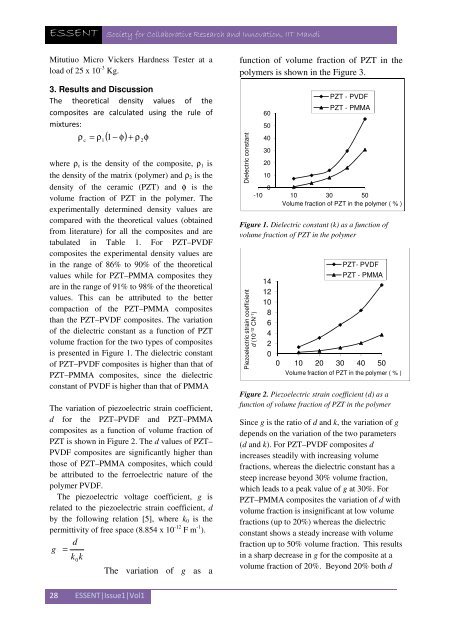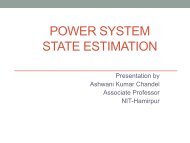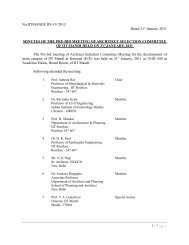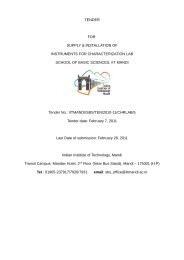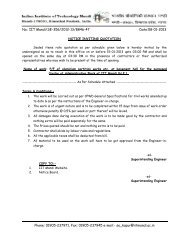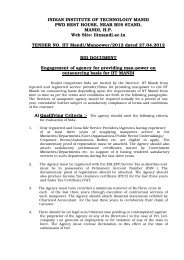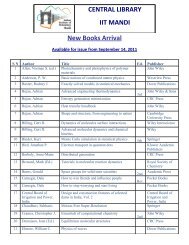Issue1. Vol.1 (April, 2013) - IIT Mandi
Issue1. Vol.1 (April, 2013) - IIT Mandi
Issue1. Vol.1 (April, 2013) - IIT Mandi
- No tags were found...
You also want an ePaper? Increase the reach of your titles
YUMPU automatically turns print PDFs into web optimized ePapers that Google loves.
ESSENT Society for Collaborative Research and Innovation, <strong>IIT</strong> <strong>Mandi</strong>Mitutiuo Micro Vickers Hardness Tester at aload of 25 x 10 -3 Kg.3. Results and DiscussionThe theoretical density values of thecomposites are calculated using the rule ofmixtures:( − φ) + ρ φρc = ρ112where ρ c is the density of the composite, ρ 1 isthe density of the matrix (polymer) and ρ 2 is thedensity of the ceramic (PZT) and φ is thevolume fraction of PZT in the polymer. Theexperimentally determined density values arecompared with the theoretical values (obtainedfrom literature) for all the composites and aretabulated in Table 1. For PZT–PVDFcomposites the experimental density values arein the range of 86% to 90% of the theoreticalvalues while for PZT–PMMA composites theyare in the range of 91% to 98% of the theoreticalvalues. This can be attributed to the bettercompaction of the PZT–PMMA compositesthan the PZT–PVDF composites. The variationof the dielectric constant as a function of PZTvolume fraction for the two types of compositesis presented in Figure 1. The dielectric constantof PZT–PVDF composites is higher than that ofPZT–PMMA composites, since the dielectricconstant of PVDF is higher than that of PMMAThe variation of piezoelectric strain coefficient,d for the PZT–PVDF and PZT–PMMAcomposites as a function of volume fraction ofPZT is shown in Figure 2. The d values of PZT–PVDF composites are significantly higher thanthose of PZT–PMMA composites, which couldbe attributed to the ferroelectric nature of thepolymer PVDF.The piezoelectric voltage coefficient, g isrelated to the piezoelectric strain coefficient, dby the following relation [5], where k 0 is thepermittivity of free space (8.854 x 10 -12 F m -1 ).dg =k k0The variation of g as afunction of volume fraction of PZT in thepolymers is shown in the Figure 3.Dielectric constant6050403020100-10 10 30 50Volume fraction of PZT in the polymer ( % )Figure 1. Dielectric constant (k) as a function ofvolume fraction of PZT in the polymerPiezoelectric strain coefficientd (10 -12 CN -1 )14121086420PZT - PVDFPZT - PMMAPZT- PVDFPZT - PMMA0 10 20 30 40 50Volume fraction of PZT in the polymer ( % )Figure 2. Piezoelectric strain coefficient (d) as afunction of volume fraction of PZT in the polymerSince g is the ratio of d and k, the variation of gdepends on the variation of the two parameters(d and k). For PZT–PVDF composites dincreases steadily with increasing volumefractions, whereas the dielectric constant has asteep increase beyond 30% volume fraction,which leads to a peak value of g at 30%. ForPZT–PMMA composites the variation of d withvolume fraction is insignificant at low volumefractions (up to 20%) whereas the dielectricconstant shows a steady increase with volumefraction up to 50% volume fraction. This resultsin a sharp decrease in g for the composite at avolume fraction of 20%. Beyond 20% both d28 ESSENT|Issue1|Vol1


